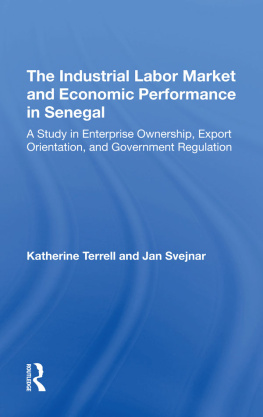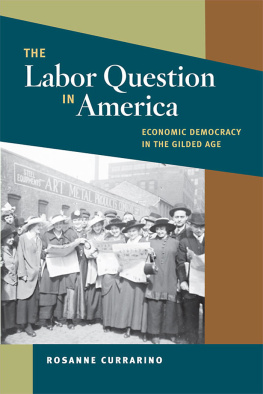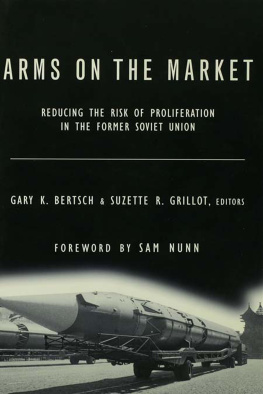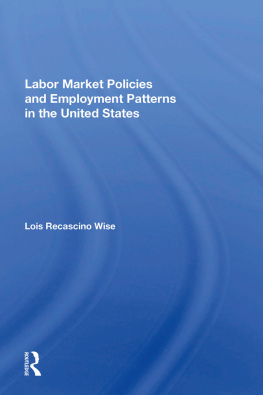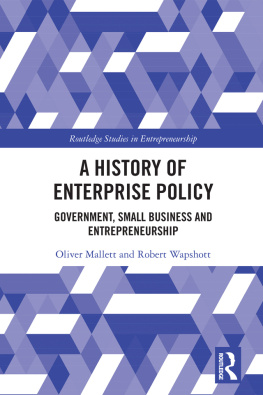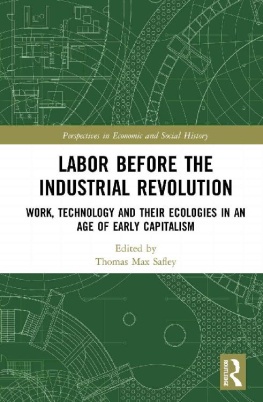The Industrial Labor Market and Economic Performance in Senegal
First published 1989 by Westview Press
Published 2019 by Routledge
52 Vanderbilt Avenue, New York, NY 10017
2 Park Square, Milton Park, Abingdon, Oxon OX14 4RN
Routledge is an imprint of the Taylor & Francis Group, an informa business
Copyright 1989 Taylor & Francis
All rights reserved. No part of this book may be reprinted or reproduced or utilised in any form or by any electronic, mechanical, or other means, now known or hereafter invented, including photocopying and recording, or in any information storage or retrieval system, without permission in writing from the publishers.
Notice:
Product or corporate names may be trademarks or registered trademarks, and are used only for identification and explanation without intent to infringe.
Library of Congress Cataloging-in-Publication Data
Terrell. Katherine D.
The industrial labor market and economic performance in Senegal:
a study in enterprise ownership. export orientation. and government
regulation / by Katherine Terrell and Jan Svejnar.
p. cm.
Bibliography: p.
Includes index.
1. Labor marketSenegal. 2. SenegalIndustries. I.
Svejnar. Jan. II. Title.
HD5847.7.A6T47 1989
331.1209663dc20
89-8997
CIP
ISBN 13: 978-0-367-29307-9 (hbk)
To our parents
Contents
, Guy Pfeffermann
Guide
Nearly 25 years ago, I interviewed industrial workers and their employers in Senegal. Industrial Labor in the Republic of Senegal (Praeger, New York, 1968) tells the story. Labor market imperfections, mostly inherited from French colonial legislation and institutions but also rooted in the extended family system, were so egregious as to stifle development. The replacement of expatriates by African workers was proceeding at a snails pace, government and union wage policies were curbing employment growth, vocational schools were turning out graduates unsuitable for industrial employment. Wage and other regulations intended to advance the workers welfare failed to achieve their objectives. The extended family system obliged workers to support a multitude of unemployed hangers-on, all the more numerous owing to polygamism, and this undercut incentives to strive for better pay and to save more. Labor market distortions encouraged enterprises to use capital-intensive methods of production rather than to expand employment. And a parallel informal sector had sprung up of firms small enough to evade labor legislation.
Like the Three Musketeers, Terrell and Svejnar have revisited the Senegalese labor market 20 years or so later. Undoubtedly, some things have changed. Fewer expatriates are now working in Senegal. But the striking picture which emerges is that things mostly have remained unchanged. Labor regulations are still pervasive and largely self-defeating. Labor productivity remains low. The supply of skilled workers remains limited. And the burden of the extended family on wage-earners has become even greater. The authors document this unhappy situation very carefully with the help of interviews and detailed surveys and ask themselves to what extent Senegals uncommonly poor growth performance can be traced to labor market imperfections. They draw policy implications and make recommendations that address some of the root causes of stagnation. These should be of great interest to the government, which has been striving to improve the structure of the economy so as to accelerate growth in a sustainable manner. The book will also be of interest to other developing countries whose labor market institutions have much in common with Senegals.
Guy Pfeffermann
Economic Adviser to the International Finance Corporation
World Bank Group
The research for this monograph was in large part funded by grant no. 67403 of the World Bank Research Committee. We are especially indebted to Guy Pfeffermann for conceiving the idea and assisting us in launching and implementing the project. Without his guidance and supervision the study would not have been realized. We are also grateful to a number of other individuals and organizations that provided invaluable help during the research project: Mark Leiserson contributed enormously to the projects formation, and the World Bank Senegal Division, the Industrial Strategy and Polity Division, and the World Bank Resident Mission in Dakar assisted in our fieldwork. We are particularly grateful to Kemal Dervis, Christian Duvigneau, Nicolas Gorjestani, Frans Kaps, Christopher Redfem, and Eugene Scanteie.
We extend special thanks to Mme. Thiongane, the Director of Statistics at the Ministry of Finance in Senegal, for providing us with the data; to Prospere Youm, the Director of Forecasting at the Ministry of Finance, for providing data on the effective rate of protection; and to Alhousseney Sy, the Chief of the Census Bureau, for collaborating with us on the sample survey. The trade union representatives and numerous enterprise managers who provided us with their perspectives have made valuable contributions to our understanding of Senegals industrial sector and its labor market institutions.
Finally, we thank Bela Balassa, Guy Standing, Gerald Starr, Erik Thorbecke, and the participants at the World Bank seminar for their many helpful comments, Sathi Pandian and Seng-Lee Wong for their excellent computational assistance, and Lauree Graham for invaluable help in the preparation of the manuscript. All remaining errors are our own.
Katherine Terrell
Jan Svejnar
1
Introduction
Senegal is in the grip of a long-term economic crisis. Since 1960, it has experienced the smallest growth in gross domestic product (GDP)--2.3 percent--of any African country not affected by war or civil strife. Moreover, data suggest that the GDP per capita has been at best stagnant and probably falling over the last twenty years as the productivity and real income of most of the population have not been raised since independence. Since the late 1970s the Senegalese government has recognized the need to embark on a sustained and long-term adjustment program and has searched for appropriate policies to pursue this goal. In this context, an important objective of this study is to provide an upto-date analysis of several issues that are pertinent to the ongoing debate in the choice of appropriate adjustment policies in Senegal. Since many problems examined in this study have been encountered in other countries, we hope that our analysis also has broader policy ramifications.
One of the structural causes of the current economic crisis is believed to be the inability of the modern sector to raise its overall share of employment as well as its productivity and average real earnings in the past two decades. The sluggish performance of the modern (formal) industrial sector has been the subject of major debate, given that the sector had a relatively mature base at independence, has received considerable investment since then, and has enjoyed significant protection as well as preferential trade agreements in both the European (EEC) and West African (CEAO) Economic Community.
Most economists agree that employment in the informal urban sector has grown over the past two decades but that the formal sector has not generated much employment and has instead switched to more capital-intensive methods of production. It is also suggested that public enterprises have been the only significant providers of jobs in the modern sector. A recent study by Mingat (1982) claims, however, that employment generation in the informal sector has slowed. What has increased, according to this study, is the level of open unemployment in the urban labor market. These opposing views illustrate the prevailing lack of basic knowledge about the structural features and functioning of Senegals industrial sector and labor market. They have also provided us with an important motivation for undertaking the present study.

